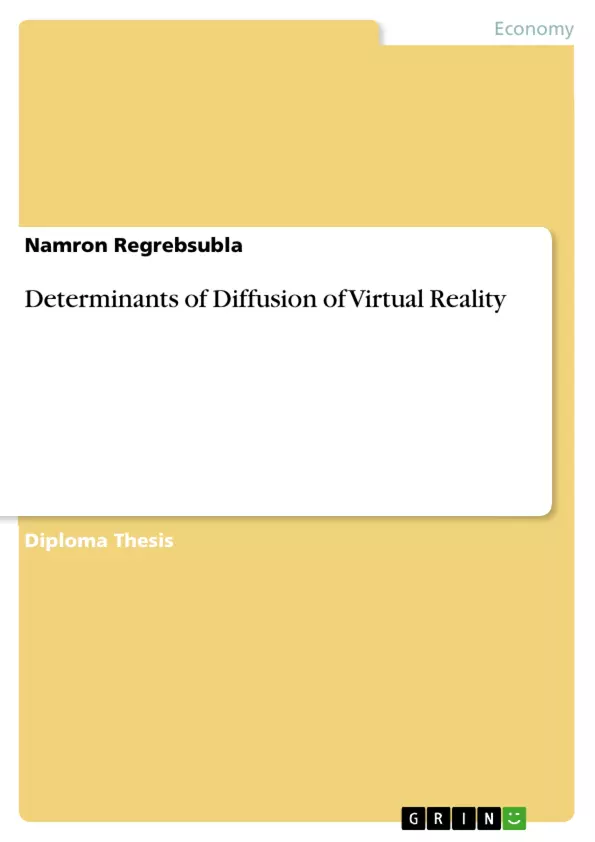The paper develops a definition of VR based on a theoretical construct and a diffusion scenario based on the theories of adoption and diffusion of innovations.
Numerous important researchers, as well as the mass media are describing Virtual Reality as a milestone of technological development. The age of VR has just begun, and will change the way we communicate, consume and also we will work. It is reasonable to assume VR as the next dominant medium of the future. Predictions made on VR technology foresee an adoption within society and mass markets in future times, yet lack the ability to find specific determinants of a positive diffusion scenario.
Every technological revolution, beginning with the invention of the hand axe, the wheel, train tracks, the telephone, television, all the way up to the computer; they all had a influence on society and its economy. The technological advances press a continuous demand for new answers to an outdated political and jurisdictional system. Thereby, society as a whole is forced to undergo reconstruction.
Inhaltsverzeichnis (Table of Contents)
- 1 Abstract
- 2 Introduction
- 2.1 Problem and Goal
- 2.2 Thesis Structure
- 3 Virtual Reality Technology
- 3.1 History
- 3.2 Recent Developments
- 3.3 Definition and Distinction
- 3.4 Related Technologies
- 4 Theoretical Framework
- 4.1 Innovation Diffusion Processes
- 4.1.1 Innovation
- 4.1.2 Adoption
- 4.2 Additional Terms
- 4.2.1 Diffusion Theory by Rogers
- 4.2.2 Awareness
- 4.2.3 The Bass Diffusion Model
- 4.3 Compatibility and Network Effects
- 4.1 Innovation Diffusion Processes
- 5 Virtual Reality - The Object of Diffusion
- 5.1 Determinants of successfull Diffusion
- 5.2 Finding initial Markets
- 5.2.1 The Gaming Industry
- 5.2.2 The Adult Industry
- 5.3 Model Evaluation
- 5.3.1 Critical Examination
- 6 Conclusion and further Questions
- 6.1 What can hamper the Diffusion?
- 6.2 Closing Comments
Zielsetzung und Themenschwerpunkte (Objectives and Key Themes)
This diploma thesis aims to explore the factors influencing the diffusion of virtual reality (VR) technology. The research investigates the historical development of VR, its current state, and key theoretical frameworks for understanding innovation adoption. The thesis analyzes the potential of VR in specific industries and examines factors that could hinder its widespread adoption.
- The history and evolution of virtual reality technology.
- Theoretical frameworks for understanding innovation diffusion processes.
- Identifying potential markets for virtual reality adoption.
- Factors influencing the successful diffusion of virtual reality.
- Potential challenges and barriers to widespread VR adoption.
Zusammenfassung der Kapitel (Chapter Summaries)
- Chapter 1 provides a brief overview of the thesis, outlining its objectives and research questions.
- Chapter 2 introduces the concept of virtual reality, tracing its historical development and highlighting recent technological advancements. It also defines VR and differentiates it from related technologies.
- Chapter 3 delves into theoretical frameworks for understanding innovation diffusion processes, focusing on the concept of innovation adoption and related theories like Rogers' Diffusion Theory and the Bass Diffusion Model.
- Chapter 4 examines virtual reality as an object of diffusion, analyzing determinants of successful adoption and identifying potential initial markets, particularly in the gaming and adult industries.
- Chapter 5 evaluates the conceptual model for VR diffusion and critically examines its strengths and limitations.
- Chapter 6 concludes the thesis by discussing potential challenges and barriers to the widespread adoption of virtual reality and offering further research questions.
Schlüsselwörter (Keywords)
The main keywords and focus topics of this thesis include virtual reality, innovation diffusion, adoption, theoretical frameworks, Rogers' Diffusion Theory, the Bass Diffusion Model, gaming industry, adult industry, market saturation, and challenges to VR adoption.
- Citar trabajo
- Namron Regrebsubla (Autor), 2015, Determinants of Diffusion of Virtual Reality, Múnich, GRIN Verlag, https://www.grin.com/document/318329



